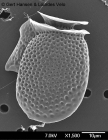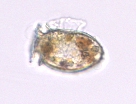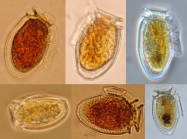
| Intro | | Search taxa | | Browse taxa | | Distributions | | Terminology | | References | | Statistics | | Online sources | | Tutorial | | Log in |
WRiMS taxon detailsDinophysis acuminata Claparède & Lachmann, 1859
109603 (urn:lsid:marinespecies.org:taxname:109603)
accepted
Species
marine,
Claparède E. & Lachmann J. (1858). Etudes sur les Infusoires et les Rhizopodes. <em>Mém. Inst. Genev.</em> 5, 6: 489 pp. [details]
Guiry, M.D. & Guiry, G.M. (2024). AlgaeBase. World-wide electronic publication, National University of Ireland, Galway (taxonomic information republished from AlgaeBase with permission of M.D. Guiry). Dinophysis acuminata Claparède & Lachmann, 1859. Accessed through: Costello, M. J.; Ahyong, S.; Bieler, R.; Boudouresque, C.; Desiderato, A.; Downey, R.; Galil, B. S.; Gollasch, S.; Hutchings, P.; Kamburska, L.; Katsanevakis, S.; Kupriyanova, E.; Lejeusne, C.; Ma, K. C. K.; Marchini, A.; Occhipinti, A.; Pagad, S.; Panov, V. E.; Poore, G. C. B.; Rewicz, T.; Robinson, T. B.; Rius, M.; Sobczyk, R.; Stern, N.; Turon, X.; Valls Domedel, G.; Verleye, T.; Vieira, L. M.; Willan, R. C.; Yeo Chong Jinn, D.; Zhan, A. (2024) World Register of Introduced Marine Species (WRiMS) at: https://www.marinespecies.org/introduced./aphia.php?p=taxdetails&id=109603 on 2025-04-17
Costello, M. J.; Ahyong, S.; Bieler, R.; Boudouresque, C.; Desiderato, A.; Downey, R.; Galil, B. S.; Gollasch, S.; Hutchings, P.; Kamburska, L.; Katsanevakis, S.; Kupriyanova, E.; Lejeusne, C.; Ma, K. C. K.; Marchini, A.; Occhipinti, A.; Pagad, S.; Pino, L.; Poore, G. C. B.; Rewicz, T.; Rius, M.; Robinson, T. B.; Sobczyk, R.; Stępień, A.; Turon, X.; Valls Domedel, G.; Verleye, T.; Vieira, L. M.; Willan, R. C.; Zhan, A. (2025). World Register of Introduced Marine Species (WRiMS). Dinophysis acuminata Claparède & Lachmann, 1859. Accessed at: https://marinespecies.org/introduced%20/aphia.php/api-docs/docs/LOG_0001&physid=PHYS_0004/aphia.php?p=taxdetails&id=109603 on 2025-04-17
original description
Claparède E. & Lachmann J. (1858). Etudes sur les Infusoires et les Rhizopodes. <em>Mém. Inst. Genev.</em> 5, 6: 489 pp. [details]
context source (HKRMS) Lam CWY. & Ho KC. (1988). Phytoplankton characteristics of Tolo Harbour. In: Morton B, editor. Asian Marine Biology 6. pp 5-18. Hong Kong University Press, Hong Kong. [details] context source (Schelde) Maris, T., O. Beauchard, S. Van Damme, E. Van den Bergh, S. Wijnhoven & P. Meire. (2013). Referentiematrices en Ecotoopoppervlaktes Annex bij de Evaluatiemethodiek Schelde-estuarium Studie naar “Ecotoopoppervlaktes en intactness index”. [Reference matrices and Ecotope areas Annex to the Evaluation methodology Scheldt estuary Study on “Ecotope areas and intactness index”. <em>Monitor Taskforce Publication Series, 2013-01. NIOZ: Yerseke.</em> 35 pp. (look up in IMIS) [details] basis of record Brandt, S. (2001). Dinoflagellates, <B><I>in</I></B>: Costello, M.J. <i>et al.</i> (Ed.) (2001). <i>European register of marine species: a check-list of the marine species in Europe and a bibliography of guides to their identification. Collection Patrimoines Naturels,</i> 50: pp. 47-53 (look up in IMIS) [details] additional source Brunel, P., L. Bosse & G. Lamarche. (1998). Catalogue of the marine invertebrates of the estuary and Gulf of St. Lawrence. <em>Canadian Special Publication of Fisheries and Aquatic Sciences, 126.</em> 405 pp. (look up in IMIS) [details] Available for editors additional source Horner, R. A. (2002). A taxonomic guide to some common marine phytoplankton. <em>Biopress Ltd. Bristol.</em> 1-195. [details] additional source Martin, J. L.; LeGresley, M. M. ; Strain, P. M. (2001). Phytoplankton monitoring in the Western Isles region of the Bay of Fundy during 1997-98. <em>Canadian Technical Report of Fisheries and Aquatic Sciences 2349.</em> 4: 1-85. [details] additional source Rosenberg, G. 2004. Malacolog Version 3.3.2: Western Atlantic gastropod database. The Academy of Natural Sciences, Philadelphia, PA., available online at http://www.malacolog.org [details] additional source Gómez, F. (2005). A list of free-living dinoflagellate species in the world's oceans. <em>Acta Bot. Croat.</em> 64(1): 129-212. [details] additional source Guiry, M.D. & Guiry, G.M. (2025). AlgaeBase. <em>World-wide electronic publication, National University of Ireland, Galway.</em> searched on YYYY-MM-DD., available online at http://www.algaebase.org [details] additional source Integrated Taxonomic Information System (ITIS). , available online at http://www.itis.gov [details] additional source Tomas, C.R. (Ed.). (1997). Identifying marine phytoplankton. Academic Press: San Diego, CA [etc.] (USA). ISBN 0-12-693018-X. XV, 858 pp., available online at http://www.sciencedirect.com/science/book/9780126930184 [details] additional source Abé, T.H. (1967). The armoured Dinoflagellata: II. Prorocentridae and Dinophysidae (B) - <i>Dinophysis</i> and its allied genera. <em>Publications of the Seto Marine Biological Laboratory.</em> 2: 37-78. [details] Available for editors additional source Lee J.S., lgarashi T., Fraga S., Dahl E., Hovgaard P. & Yasumoto T. (1989). Determination of diarrhetic shellfish toxins in various dinoflagellate species. <em>J. Appl. Phycol.</em> 1, 147-152. [details] additional source Steidinger, K. A., M. A. Faust, and D. U. Hernández-Becerril. 2009. Dinoflagellates (Dinoflagellata) of the Gulf of Mexico, Pp. 131–154 in Felder, D.L. and D.K. Camp (eds.), Gulf of Mexico–Origins, Waters, and Biota. Biodiversity. Texas A&M Press, College [details] additional source Moestrup, Ø., Akselman, R., Cronberg, G., Elbraechter, M., Fraga, S., Halim, Y., Hansen, G., Hoppenrath, M., Larsen, J., Lundholm, N., Nguyen, L. N., Zingone, A. (Eds) (2009 onwards). IOC-UNESCO Taxonomic Reference List of Harmful Micro Algae., available online at http://www.marinespecies.org/HAB [details] additional source Liu, J.Y. [Ruiyu] (ed.). (2008). Checklist of marine biota of China seas. <em>China Science Press.</em> 1267 pp. (look up in IMIS) [details] Available for editors additional source Lakkis, S. (2011). Le phytoplancton marin du Liban (Méditerranée orientale): biologie, biodiversité, biogéographie. Aracne: Roma. ISBN 978-88-548-4243-4. 293 pp. (look up in IMIS) [details] additional source Chang, F.H.; Charleston, W.A.G.; McKenna, P.B.; Clowes, C.D.; Wilson, G.J.; Broady, P.A. (2012). Phylum Myzozoa: dinoflagellates, perkinsids, ellobiopsids, sporozoans, in: Gordon, D.P. (Ed.) (2012). New Zealand inventory of biodiversity: 3. Kingdoms Bacteria, Protozoa, Chromista, Plantae, Fungi. pp. 175-216. [details] additional source Steidinger, K.A.; Tangen, K. (1997). Dinoflagellates. pp. 387-584. In: C.R. Tomas (ed.) (1997). Identifying Marine Phytoplankton. Academic Press: San Diego, CA [etc.] (USA). ISBN 0-12-693018-X. XV, 858 pp., available online at http://www.sciencedirect.com/science/article/pii/B9780126930184500057 [details] additional source Balech, E. (2002). Dinoflagelados tecados tóxicos en el Cono Sur Americano. <em>In: Sar, E.A., Ferrario, M.E. & Reguera, B. (Eds.). Floraciones Algales Nocivas en el Cono Sur Americano. Instituto Español de Oceanografía.</em> pp. 123-144. [details] Available for editors ecology source Hansen, P. J.; Tillmann, U. (2020). Mixotrophy in Dinoflagellates: Prey Selection, Physiology and Ecological Importance in Dinoflagellates: Classification, Evolution, Physiology and Ecological Significance. <em>Ed: Subba Rao Durvasula. Publisher: Nova Science Publishers, Inc. New York, USA.</em> [details] ecology source Leles, S. G.; Mitra, A.; Flynn, K. J.; Stoecker, D. K.; Hansen, P. J.; Calbet, A.; McManus, G. B.; Sanders, R. W.; Caron, D. A.; Not, F.; Hallegraeff, G. M.; Pitta, P.; Raven, J. A.; Johnson, M. D.; Glibert, P. M.; Våge, S. (2017). Oceanic protists with different forms of acquired phototrophy display contrasting biogeographies and abundance. <em>Proceedings of the Royal Society B: Biological Sciences.</em> 284(1860): 20170664., available online at https://doi.org/10.1098/rspb.2017.0664 [details] Available for editors ecology source Mitra, A.; Caron, D. A.; Faure, E.; Flynn, K. J.; Leles, S. G.; Hansen, P. J.; McManus, G. B.; Not, F.; Do Rosario Gomes, H.; Santoferrara, L. F.; Stoecker, D. K.; Tillmann, U. (2023). The Mixoplankton Database (MDB): Diversity of photo‐phago‐trophic plankton in form, function, and distribution across the global ocean. <em>Journal of Eukaryotic Microbiology.</em> 70(4)., available online at https://doi.org/10.1111/jeu.12972 [details] ecology source Jacobson, D. M.; Andersen, R. A. (1994). The discovery of mixotrophy in photosynthetic species of Dinophysis (Dinophyceae): light and electron microscopical observations of food vacuoles in Dinophysis acuminata, D. norvegica and two heterotrophic dinophysoid dinoflagellates. <em>Phycologia.</em> 33(2): 97-110., available online at https://doi.org/10.2216/i0031-8884-33-2-97.1 [details] ecology source Park, M.; Kim, S.; Kim, H.; Myung, G.; Kang, Y.; Yih, W. (2006). First successful culture of the marine dinoflagellate Dinophysis acuminata. <em>Aquatic Microbial Ecology.</em> 45: 101-106., available online at https://doi.org/10.3354/ame045101 [details] ecology source Garcia-Cuetos, L.; Moestrup, Ø.; Hansen, P. J.; Daugbjerg, N. (2010). The toxic dinoflagellate Dinophysis acuminata harbors permanent chloroplasts of cryptomonad origin, not kleptochloroplasts. <em>Harmful Algae.</em> 9(1): 25-38., available online at https://doi.org/10.1016/j.hal.2009.07.002 [details]  Present Present  Inaccurate Inaccurate  Introduced: alien Introduced: alien  Containing type locality Containing type locality
From regional or thematic species database
Introduced species impact Chinese part of the Yellow Sea (Marine Region) Other impact - undefined or uncertain (Bloom forming) [details]Introduced species vector dispersal Chinese part of the Yellow Sea (Marine Region) Ships: General [details] Introduced species vector dispersal Chilean part of the South Atlantic Ocean (Marine Region) Ships: accidental with ballast water, sea water systems, live wells or other deck basins [details] |





